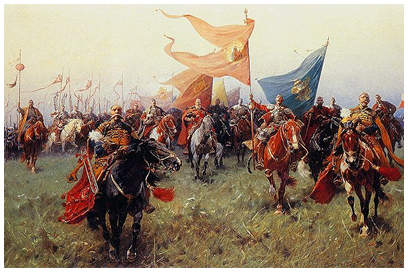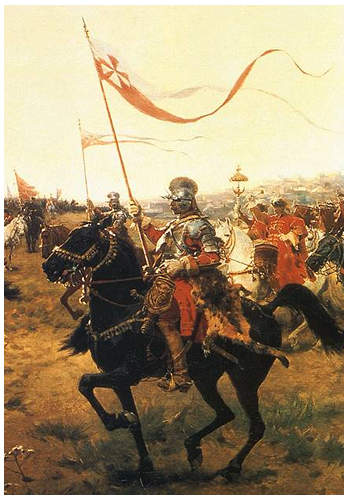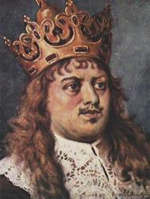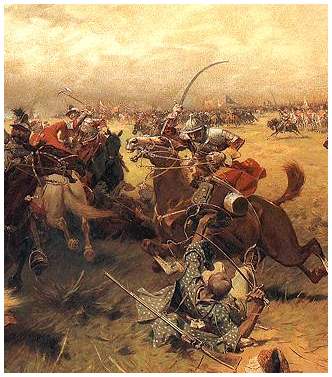
Summary of Conflicts
|
1660-1672 (links to map of Poland) The Muscovite
war (Continued) At the time of the Peace of Oliwa a large Muscovite army approached Warsaw while another entered the Ukraine. But with peace ensured with Sweden, Poland began its own offensive which was to reveal to the full aggressive spirit of the Polish-Lithuanian army and its commanders. In the Ukraine Field Hetman Jerzy Lubomirski brilliantly led the Polish forces against Szerement and Jurek Chmilniecki. At Lubar the Poles held off the Muscovites forcing them on the defensive where at Cudnow they surrounded and besieged them, ensuring their surrender on 1st November 1660. Lubomirski then moved with his best troops and the Tartars, to deal with the Cossacks who he defeated and then besieged at Slobodyszcze and forced them to capitulate.
These defeats left Muscovy powerless. But the superb campaigns brought few fruits since in Lithuania the army mutinied and demanded its back pay. In 1663 Jan Kazimierz invaded the Ukraine, but the Muscovites had learnt from bitter experience. They avoided battle and sheltered in fortified towns or retreated. The King attempted to reform the decrepit state organisation, but in 1666 the powerful and disenchanted Lubomirski led a rebellion and defeated the King's forces at Matwy (13th July 1666). The chance at reform had failed and the rebellion only succeeded in ruining the Republic further. On 31st January 1667 the Truce of Andruszow was concluded with Muscovy. This was more advantageous to the Muscovites than was reflected in their military success, principally due to the rebellion in Poland. Poland ceded the Smolensk. Seversk and Czernihow regions and the Ukraine was divided along the Dniepr. The Poles intended this to be a temporary setback, until they got their house in order, however this was not to be. What began as a popular rising of the Ukrainian people ended in ruin to their lands and their national aspirations, with the Ukraine divided in two. They also found that life under Muscovy was much sterner than that under Warsaw and by the time of Peter the Great and Catherine II Ukrainian autonomy had been dealt its final death blow (until the 1990's!). The
Turkish and Tartar Wars In an attempt to curb the Tartar ravaging, Sobieski introduced a new tactic. Previously when the enemy's numbers were so superior the army was placed in a single fortified camp in a strategic position. It's main problem was it allowed the Tartars complete freedom to carry out their ravaging of the surrounding lands. Sobieski split his forces into small independent groups, each based at one of a line of forts and supported by the local population. These forces could hamper the operation of the numerous but small Tartar raiding parties, and when threatened by a larger force it could seek refuge in the fort. Sobieski took
3,000 troops to a fortified camp at Podhajce,
threatening the enemy's communication lines, and was besieged. The
initial Tartar-Cossack attacks failed and a Polish night attack
forced the numerically much superior enemy to agree to a truce and
On 16th August 1668 Jan Kazimierz, a broken man after Matwy and then the death of his wife, resigned the crown and soon left for France. A year later on 29th September 29 year old Prince Michael Wisniowiecki, a Pole from an illustrious family (Piast), was crowned King. But the Podhajce agreement brought only a brief respite. The Cossacks now submitted to the Sultan as they tried to play the Muscovites, Turks and Poles against each other. Soon, in July 1671 the Cossacks besieged Biala Cerki while the Tartars moved into Podole, now supported by the Ottomans.
|
|
![]()
 In
1658 the Muscovites renewed their attacks, after having their own
problems with Sweden, defeating Lithuanian forces at
In
1658 the Muscovites renewed their attacks, after having their own
problems with Sweden, defeating Lithuanian forces at  At
the same time the Lithuanian Hetman Sapieha and Czarniecki fought
the Muscovites in Lithuania. Their 15,000 Polish-Lithuanian army
defeated the Muscovite Northern army at
At
the same time the Lithuanian Hetman Sapieha and Czarniecki fought
the Muscovites in Lithuania. Their 15,000 Polish-Lithuanian army
defeated the Muscovite Northern army at  retreat.
retreat.
 Sobieski,
with only weak forces repeated his very successful tactics of the
previous year and led two attacks which broke the new Cossack-Tartar
offensive. He led a 150 mile raid capturing many strongholds and
by mid-October much of the Ukraine was subdued. Had he had some
support, much of the lands. effectively lost since 1648, could have
been regained. Instead Sobieski was forced to return and the Ukraine
rebelled again.
Sobieski,
with only weak forces repeated his very successful tactics of the
previous year and led two attacks which broke the new Cossack-Tartar
offensive. He led a 150 mile raid capturing many strongholds and
by mid-October much of the Ukraine was subdued. Had he had some
support, much of the lands. effectively lost since 1648, could have
been regained. Instead Sobieski was forced to return and the Ukraine
rebelled again.